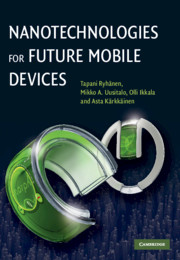Book contents
- Frontmatter
- Contents
- List of contributors
- Preface
- 1 When everything is connected
- 2 On the possible developments for the structural materials relevant for future mobile devices
- 3 Energy and power
- 4 Computing and information storage solutions
- 5 Sensing, actuation, and interaction
- 6 Future of Radio and Communication
- 7 Flat panel displays
- 8 Manufacturing and open innovation
- 9 Seeing beyond the hype: what the Internet teaches us about the development of nanotechnology
- 10 Conclusions
- Index
- References
3 - Energy and power
Published online by Cambridge University Press: 05 July 2014
- Frontmatter
- Contents
- List of contributors
- Preface
- 1 When everything is connected
- 2 On the possible developments for the structural materials relevant for future mobile devices
- 3 Energy and power
- 4 Computing and information storage solutions
- 5 Sensing, actuation, and interaction
- 6 Future of Radio and Communication
- 7 Flat panel displays
- 8 Manufacturing and open innovation
- 9 Seeing beyond the hype: what the Internet teaches us about the development of nanotechnology
- 10 Conclusions
- Index
- References
Summary
Energy needs of future mobile devices
Renewable energy – portable energy sources
The increasing need for portable energy storage density due to the growing number of miniaturized and thin devices is driving the current development of energy storage in phones and other portable devices [1]. Figure 3.1 shows the development from the mobile phones of the 1990s to the multimedia centers of two decades later, and the evident development of the devices to thinner and more flexible forms.
The total power consumption will become even more important when more electronic devices are embedded in the environment. Also with standalone devices designed to operate without mains power supply for long periods, like years, there are new requirements. Energy storage and power management are among the top three issues for customers and developers in current and future mobile multimedia portable devices.
Improvements in conventional battery at the current yearly level are not expected to provide enough energy density to meet all the requirements of future multimedia portables. Even though the use of cellular radio frequency (RF) engine power is expected to reduce with integrated circuit (IC) process and intelligent circuit development, the increasing number of radios and integration of new digital radio, video, and multimedia broadcasting (DAB, DVB-H, DMB) and channel decoders represents a significant challenge both in terms of energy consumption and component costs. Adding wireless local area network (WLAN) and local radio capabilities increases the overall power consumption of smartphones that are already suffering from high energy drain due to the high power consumption of 2.5G/3G wireless modules.
- Type
- Chapter
- Information
- Nanotechnologies for Future Mobile Devices , pp. 51 - 75Publisher: Cambridge University PressPrint publication year: 2010



